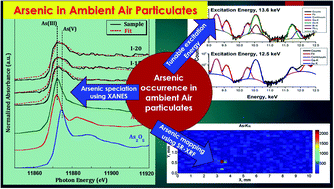Synchrotron X-ray fluorescence and X-ray absorption near edge structure of low concentration arsenic in ambient air particulates†
Abstract
Arsenic is a significant risk factor for human health, leading to various forms of cancer. The most common routes of exposure to arsenic for humans are drinking water, food, and to a lesser extent inhalation. Monitoring arsenic airborne levels becomes increasingly important. Using advanced X-ray synchrotron radiation based techniques, the occurrence of arsenic in coarse and fine particulates was investigated, namely in total suspended particulate (TSP) and particulate matter with aerodynamic diameter equal or less than 2.5 μm (PM2.5). Synchrotron radiation X-ray fluorescence was used to obtain elemental maps of arsenic in selected ambient air particulate samples. Making use of the tunability of the synchrotron source, excitation photon energies below or above the arsenic K edge (13.6 and 12.5 keV) were employed together with precise spectral de-convolution procedures, to fully elucidate the occurrence of arsenic in the spectra, and properly assess and avoid the contribution of spectral interferences in between As-K emission lines and those of Ga-Kβ, Bi-L, and L1,2 series of Pb. In the case of total suspended particulates collected from the industrial area, high content of arsenic was found (2.9 ± 0.7 ng m−3) where activities such as cement industry and alloy smelters are performed. In addition, for selected spots of high concentration in arsenic at the TSP samples, the speciation of arsenic was investigated using X-ray absorption near edge structure at the As K-edge. Applying linear combination fitting procedures to the XANES data, we could determine that 82% of the arsenic species exist in the trivalent oxidation state, whereas only 18% reveal to be present in the pentavalent oxidation state. In the case of the PM2.5 aerosol from the industrial area, the cartographies of arsenic were successfully accomplished but the XANES measurements could not be achieved due to the low concentration of arsenic (1.6 ± 0.6 ng m−3).



 Please wait while we load your content...
Please wait while we load your content...